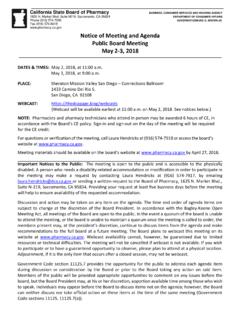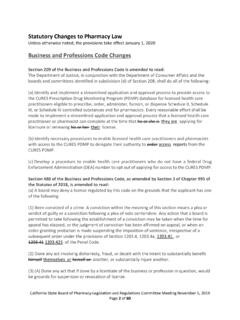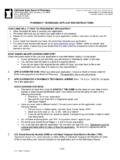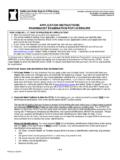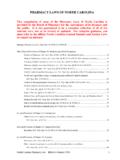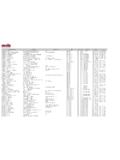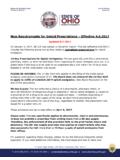Transcription of California State Board of Pharmacy and Medical …
1 California State Board of Pharmacy and Medical Board of California Transmission and Receipt of Electronic Controlled Substance Prescriptions Pursuant to DEA Interim Final Rule (IFR): Electronic Prescriptions for Controlled Substances 21 CFR Parts 1300, 1304, 1306, and 1311 (Fed. Reg. 16236-16319 (March 31, 2010)) Effective June 1, 2010. Deputy Attorney General Joshua A. Room and Deputy Attorney General Kerry Weisel May 2011. The following is merely a summary and/or paraphrasing of the law as reflected in the IFR, and/or a compilation of opinion(s) on the interpretation of the IFR. It does not constitute an official opinion of, nor is it sanctioned by, the Attorney General, the California State Board of Pharmacy , or the Medical Board of California . This is not a binding statement of pertinent law. It is a summary, and is not intended to be comprehensive.
2 It is offered as a guideline and a compilation of references to the appropriate sections of the IFR. Any person(s) wishing to understand the IFR are encouraged to review the regulation(s) themselves, and/or to consult an attorney. 1. California State Board of Pharmacy and Medical Board of California Transmission and Receipt of Electronic Controlled Substance Prescriptions Pursuant to DEA Interim Final Rule (IFR): Electronic Prescriptions for Controlled Substances 21 CFR Parts 1300, 1304, 1306, and 1311 (Fed. Reg. 16236-16319 (March 31, 2010)) effective June 1, 2010. Who is affected: Prescribers; pharmacies; application providers. To participate, each category must: Prescribers Pharmacies Application Providers Select application and Select application and Evaluate application(s). ensure it meets DEA ensure it meets DEA and/or reprogram as requirements requirements necessary Apply for identity proofing Set access controls Undergo third-party audit or certification of software Set access controls Process prescriptions Make audit/certification Sign (and archive) Archive prescriptions report available to prescriptions users/possible users Participation is voluntary.
3 1 The regulations do not mandate that prescribers use only electronic prescribing for controlled substances, nor do they require pharmacies to accept electronic controlled substance prescriptions. 2 Written prescriptions are still acceptable, as are oral prescriptions for Schedule III-V controlled substances. If used, electronic prescriptions for Schedule II-V controlled substances must meet DEA regulatory requirements. Audit and Selection of Software Application(s). Before being used to create, sign, transmit, or process controlled substance prescriptions, electronic prescribing applications or Pharmacy applications (stand-alone or integrated Electronic Medical Record (EMR) types) must have a third-party audit of the application certifying that it meets the requirements of the DEA regulations. The application provider must secure an audit from (1) a person/entity qualified to conduct a SysTrust, WebTrust, or SAS.
4 70 audit; (2) a Certified Information System Auditor that performs compliance audits; or (3) a 1. There are various incentives for electronic prescribing and use of electronic Medical records (EMR), most notably those contained in the Medicare Improvements for Patients and Providers Act of 2008 (MIPPA), and the Health Information Technology for Economic and Clinical Health (HITECH) Act, a component of the American Recovery and Reinvestment Act of 2009 (ARRA). These federal laws include incentive payments under Medicare for prescribers who reach certain e-prescribing and/or EMR thresholds. Prescribers may receive incentive payments on their billings of up to 2% in 2009 and 2010, 1% in 2011 and 2012, and in 2013; they may be hit with penalties of 1% in 2012, in 2013, and 2% in 2014 and beyond, for failure to meet these e-prescribing/EMR thresholds.
5 2. Beginning January 1, 2012, Medicare Part D prescriptions can no longer be sent to a Pharmacy by computer- generated fax. As of this date, prescriptions must be (a) transmitted electronically, (b) handed to the patient in hardcopy form, or (c) manually faxed to the Pharmacy . As of October 1, 2008, the Centers for Medicare and Medicaid Services (CMS) required all written Medicaid prescriptions be written on a tamper-resistant prescription blank. Electronic prescriptions are excluded from this requirement (and are acceptable). 2. certifying organization whose certification process has been approved by the DEA. 3 (21 CFR . ). The auditor issues a report and/or certification to the application provider. The application provider must keep that report and/or certification for two years, and make it available to any prescriber or Pharmacy that uses the application or is considering using the application.
6 (21 CFR. (f).) May be on provider's website. Prescribers and pharmacies must review audit/certification report prior to using application to confirm that it performs the appropriate functions successfully. (21 CFR . (d), (e), (a), (b).) A prescription created using an application that does not meet requirements is invalid. (21 CFR (d).). Furthermore, both prescribers and pharmacies have an ongoing responsibility to immediately cease using an application (and ensure that any designated agents also cease using the application) if: any required function of the application is disabled or appears to be functioning improperly; the application provider notifies them that a third-party audit or certification report indicates that the application no longer meets DEA requirements; or the application provider reports that the application is non-compliant.
7 (21 CFR , , ). The requirements for an electronic prescription application are quite specific. (21 CFR . ). Identity Proofing of Prescribers (Practitioners) 4. Identity proofing is the process by which a prescriber is uniquely identified, so that only that prescriber has the access necessary to authorize and sign electronic prescriptions using a software application. Identity proofing of prescriber must be done by an approved credential service provider (CSP) or certification authority (CA) [for digital certificates]. Remote identity proofing is permissible. (21 CFR ) Prescribers should consult with their selected application provider to determine which identity proofing organization to work with. Institutional prescribers can undergo identity proofing using the third-party method described above, or identity proofing can be conducted in-house by their institution(s).
8 (21 CFR . ). Once identity is verified, the prescriber is issued a two-factor authentication credential. (21 CFR. ) The two factors must be two of the following: (1) Something the prescriber knows, such as a password or PIN; (2) A hard token separate from the computer being accessed (meeting at least FIPS 140-2 Security Level 1); or (3) A biometric, such as a fingerprint or iris scan, meeting DEA criteria. (21 CFR. , ). Two-factor credentials will be used for (1) approving access controls, and (2) signing electronic prescriptions. (21 CFR ) They must always be in the exclusive control of the prescriber. (21 CFR ). Access Controls For Both Prescribers and Pharmacies 3. A follow-up audit/certification must be conducted whenever functionality related to controlled substance prescription requirements is altered, or every two years, whichever comes first.
9 (21 CFR (a)(2), (e)(2).). 4. Practitioner is used throughout the regulations where we might use prescriber. We use prescriber exclusively in this document. 3. Access controls relate to software-based specifications and restrictions that ensure that only those individuals authorized to sign prescriptions are allowed to do so, and only those persons authorized to enter information regarding dispensing, or to annotate or alter or delete prescription information, are allowed to do so. At the prescriber level, in each registered location there must be at least two individuals designated to manage access control to the application. One of these has to be the registered prescriber who has obtained two-factor authentication credentials. (21 CFR ) These access controls are required to limit the permission to sign controlled substance prescriptions to persons whose DEA registration is current and in good standing, and whose State authorization(s).
10 To prescribe are current and in good standing,. (21 CFR (b).) There is also a two- person management requirement in an institutional setting. (21 CFR ). Prescriber software application must be capable of setting logical access controls to limit permissions for both the indication that a prescription is ready for signing, and the electronic signature on the prescription, as well as for changes to the access controls themselves. (21 CFR. (b).) The software must revoke permission to sign controlled substance prescriptions on the date that any of the following is discovered: A hard token or any other authentication factor is lost, stolen or compromised; DEA registration expires without renewal; DEA. registration is terminated, revoked, or suspended; or the prescriber is no longer authorized to use the software ( , when the prescriber leaves the practice or institution).



